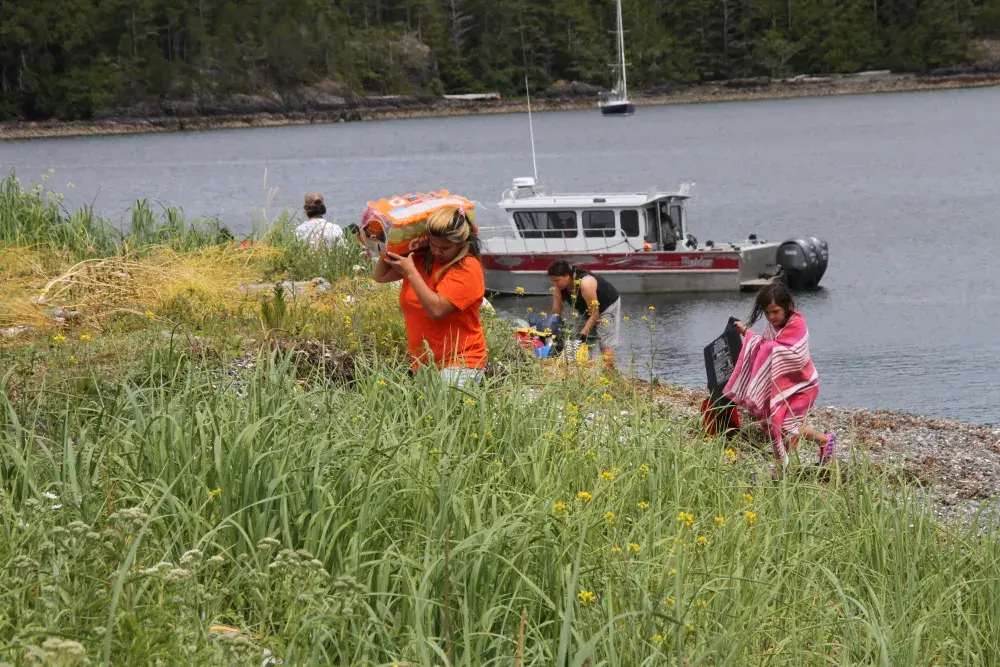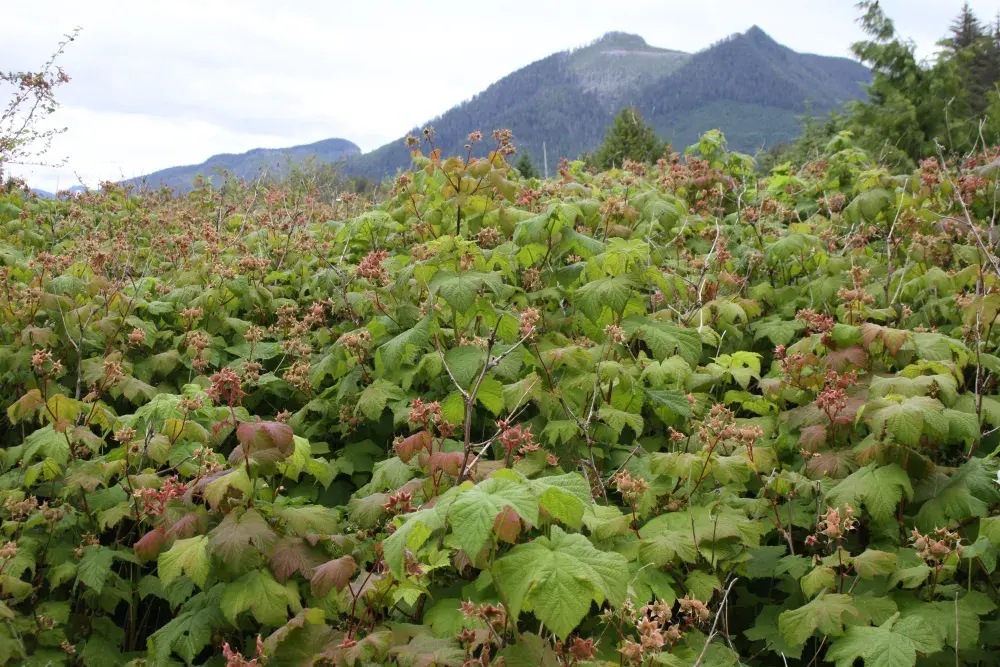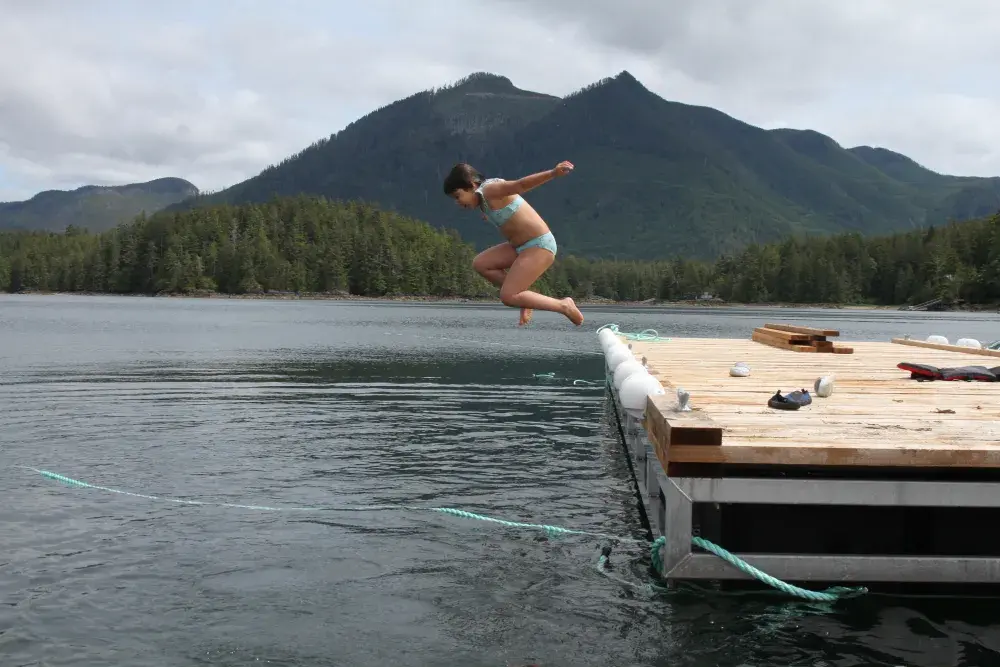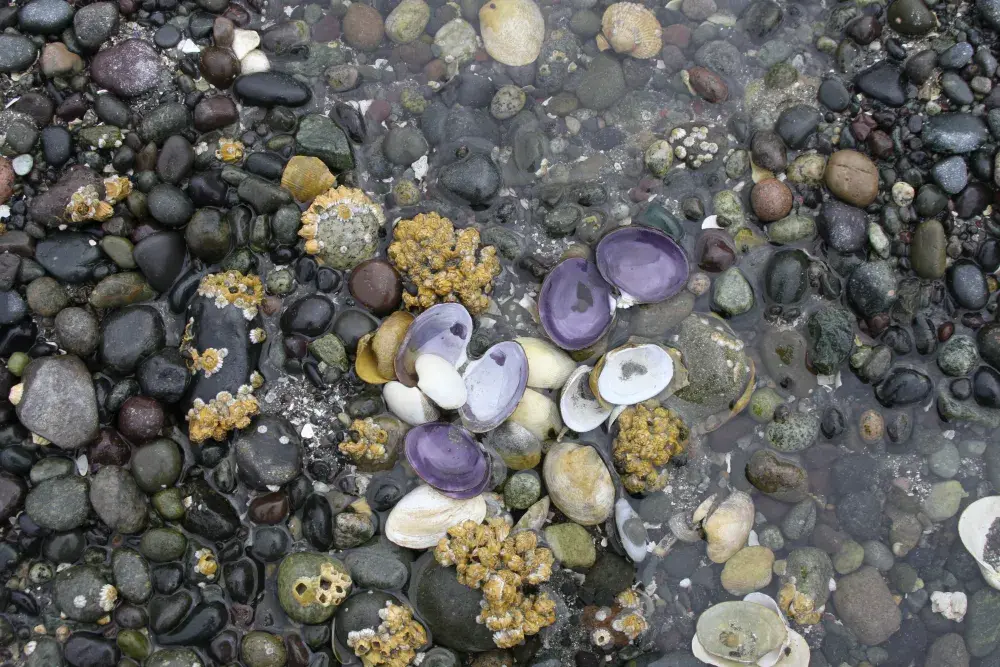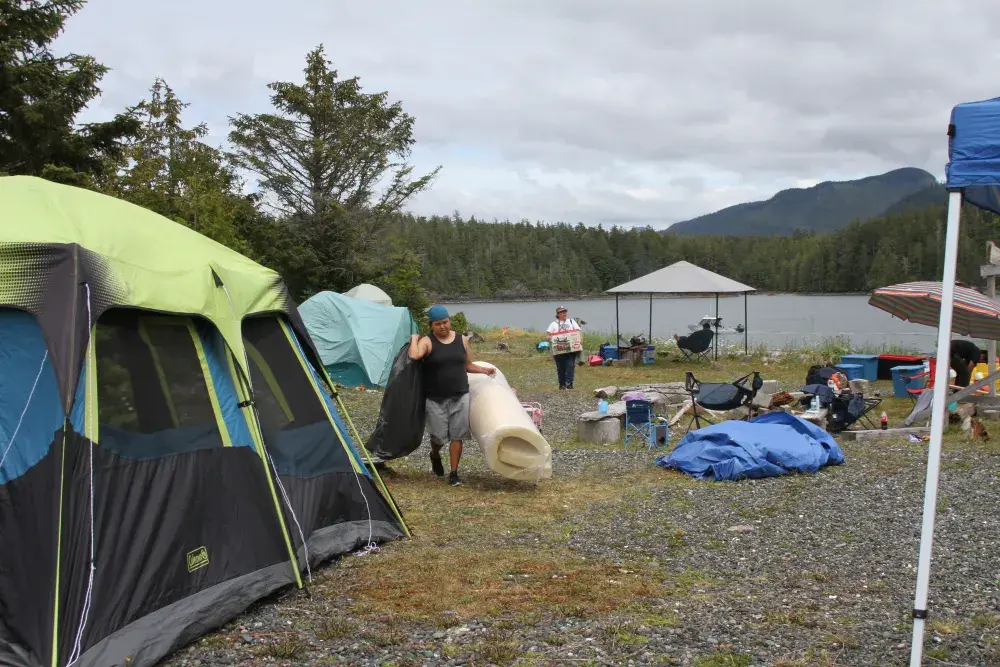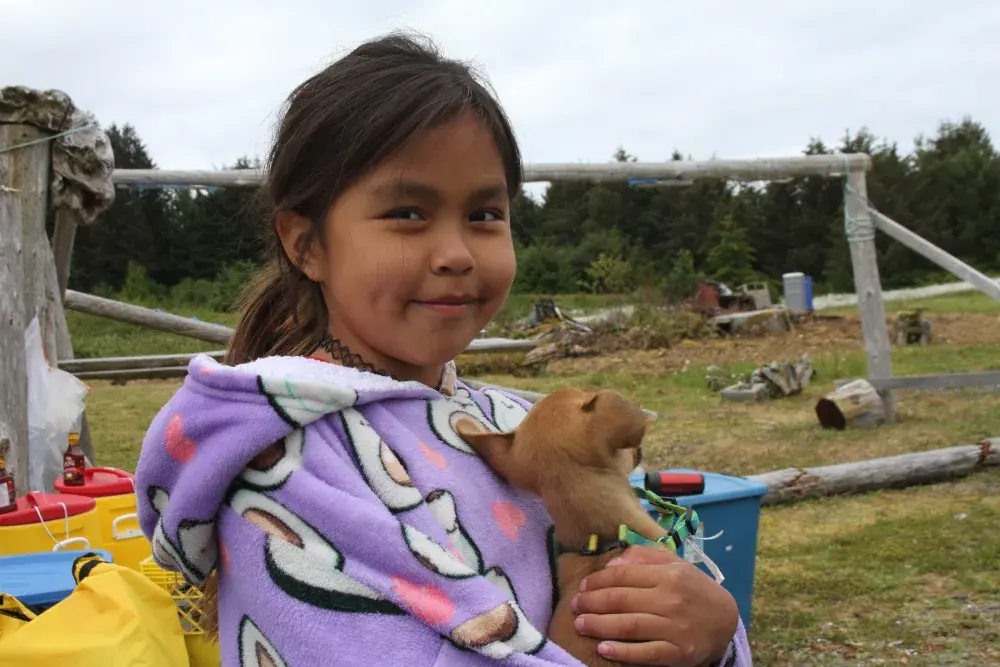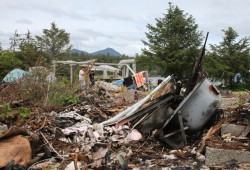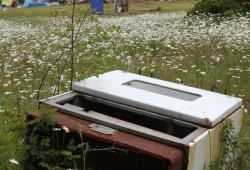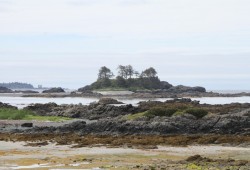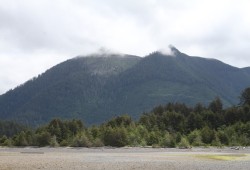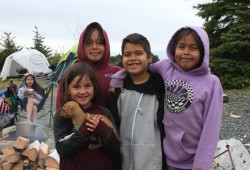On the weather-battered northwest coast of Nootka Island, rusted remnants of 20th century life can be found in the tall grass. Vegetation grows through the worn-out bottom of a pot, a 1950s-era laundry press is hidden under the flowers, while old brown springs emerge from grass, the abandoned mattress long overtaken by the elements. Walking through the overgrowth, a careful eye can spot depressions in the ground, ghostlike traces of houses that were moved from the village of Nuchatlitz years ago.
Audrey Smith spent her early childhood here before being sent to the Christie Indian Residential School at the age of five. She looks at a dense expanse of berry bushes, recalling when it was a cleared baseball field. A team from the nearby Ehattesaht village at Queens Cove used to play the local Nuchatlaht players, as they held games in each other’s communities.
“My dad said it was like that when they first moved here, 100 years ago,” commented Smith of the enormous blackberry patch. “They had to bring in machinery to take it all down.”
While Smith sits by a fire at the coastal location one summer morning, her stream of conversation is intermittently interrupted by questions from those assembling a campsite around her. Single families within the Nuchatlaht tribe usually venture to Nuchatlitz to camp each summer, but in late June of 2024 a much larger, coordinated effort is underway. As many as 100 people were expected to stay at the remote site for a few days, and for the First Nation of less than 160 members, this could be the largest event Nuchatlaht has held in years.
“We had all our family groups separate. Each family did whatever they wanted,” said Smith of past camp outs at Nuchatlitz. “This year it’s all together.”
The Nuchatlaht’s main on-reserve community is now Ocluje, north of Nuchatlitz and up Espinosa Inlet, where at most around two dozen people reside. Julie John, a cultural worker with the First Nation, sees the camp out at the former reserve village as a valuable gathering for the many members who have little direct connection to their heritage.
“I think it’s the best event we have as Nuchatlaht for building community,” she said. “Because our reserve is not allowed to get bigger, we’re dispersed across the island, across the province.”
“We still have members who have never been to Ocluje, they don’t know this island exists and they don’t know a lot of our history,” added John while helping to set up the camp on northern Nootka Island. “Some people were asking if there’s internet out here.”
With no electricity, Smith finds it beneficial for members to spend time away from the everyday technical gadgets that dominate modern life.
“To get away from all that, nobody misses it,” she said. “I think it’s the most peaceful place to come. The kids are actually relaxing.”
Four packs of wolves
Nuchatlitz is one of several village sites scattered across northern Nootka island, where traces can be found of the lives Nuchatlaht ancestors sustained for countless generations. In recent years the site, which is also referred to as nūtcȧl, has been referenced during court proceedings as the Nuchatlaht pursued a claim for Aboriginal title over the northern section of Nootka Island. In evidence presented to the court anthropologist Joan Lovisek stated that Nuchatlitz was likely the “town” where a Nuchatlaht tribe resided before 1789. According to a report from John Dewhirst, an anthropologist and archaeologist who has studied Nuu-chah-nulth for decades, by the late 1800s Nuchatlitz became the main summer village for the Nuchatlaht confederacy of local groups, replacing the nearby coastal settlement at Lūpȧtcsis for unknown reasons.
In 1889 Canada’s Indian Reserve Commissioner Peter O’Reilly met with Nuchatlaht Chief Tle-nen-o-ou-ick and Chief Maquinna of Ehattesaht to set aside reserves in the region. Described by O’Reilly as “small fishing stations”, the nine Nuchatlaht village sites became reserves, including Nuchatlitz, Lūpȧtcsis, and the more sheltered winter settlement of apȧqtū, which was located up the nearby Port Langford inlet.
“[T]he soil is poor in the extreme,” wrote O’Reilly of Nuchatlitz, “but it is valuable to the Indians, a large quantity of dogfish oil being obtained here, while salmon, halibut and bass are plentiful in the vicinity.”
Although Lūpȧtcsis appeared to be “abandoned” at the time, O’Reilly noted that this nearby site was still valuable to the Nuchatlaht in the late 1800s.
“[S]ome of the tribe continue to cultivate a few small garden patches,” wrote the commissioner. “The timber upon it is valuable for fuel and other purposes, there being none on the present village site.”
Archie Little recalls Nuchatlitz as being a place of abundance while he lived there during his early childhood in the late 1950s and early ‘60s.
“My early childhood was peace. We didn’t have to ask anybody for anything,” said Little, who remembers that his family didn’t need to venture far for sustenance. “I come from the era when there was tons and tons and tons of herring. We’d catch big salmon that got stuck in the pools as the tide was going down, so sometimes we didn’t even have to go fishing. As kids we’d go in behind the island and fish crabs for the whole community, and then we’d feed everybody.”
“I remember that we always had stuff to do,” said Jessie Mack, who like her sister Audrey Smith, spent her early childhood in Nuchatlitz. “We had to help my dad chop wood and stack wood. We didn’t have any running water here, so we had to go to the next island and they let us use the water from their well. That was our drinking water and our cooking water. We would collect rain water for flushing the toilet and washing clothes.”
Little remembers fishing in canoes, but when Mack was a youngster in the early 1970s the community had transitioned to small motor boats for trolling.
“My dad was a fisherman, so we’d have to get up early to go fishing with him,” she recalled.
“We had the sea urchins out here, we had the mussels, abalone, butter clams just down the beach here. That beach was just loaded with butter clams, now there’s nothing,” added Mack, who attributes the decline of shellfish to the resurgence of sea otters on the B.C. coast. “There’s no more big mussels, there’s no sea urchins.”
Meanwhile wild cows were nearby, feasting on the fields near the settlement. Cows once roamed in other parts of Nuu-chah-nulth territory, such as Hesquiaht and Opitsaht on Meares Island, where the bovines can still be spotted sometimes along the beach across from Tofino. These cows are the result of missionaries bringing in livestock in the 1800s, although no one is exactly sure how the animals ended up in Nuchatlitz.
“They kept our grass all short around the field,” said Mack. “We had no weed eaters or lawnmowers.”
She remembers a story her uncle Felix Michael told before he died, which led to most of the cows being killed.
“When he passed away, he said he’d come back with some wolves, four packs of wolves,” said Mack. “And then a couple of days later there was four packs of wolves that came and got some of the cows.”
A larger tide of change
The Nuu-chah-nulth language was still commonly spoken when Mack was a youngster. She recalls being in her aunt Lillian’s house, when children would gather to hear the elders sing to them in the ancestral dialect. There was a hole in the floor for someone underneath to operate a Nuu-chah-nulth-speaking puppet.
“That was how we got taught to dance in our culture,” said Mack. “Remembering back, they didn’t talk much in English at all, they always talked in their language.”
But a larger tide of change was underway. Like many generations before her, Mack was sent to Christie Indian Residential School at the age of five, where she remained for five years until her father moved her to a school in Esperanza.
Part of Canada’s assimilationist policy to mold Indigenous children into mainstream society, accounts from Christie eventually surfaced from former students, retelling experiences of physical and sexual abuse.
Emotion quickly emerges within Archie Little as he recalls returning to Nuchatlitz for the summer break.
“One thing we did not want to do was talk about the bad things,” he said. “We wanted to go there and enjoy life for two months.”
Despite the hardship at Christie, Little recalls his parents being powerless before the Catholic missionaries that ran the institution.
“They put fear into our parents that we were going to hell. I remember they encouraged my parents to have lots of kids so they could fill Christie,” he said, recalling instructions from the missionaries. “‘But,’ they said, ‘You cannot look after your kids. That’s why we’re here’.”
Meanwhile the number of people living in Nuchatlitz was declining. Little recalls approximately 100 at the village in the 1950s, but by the early 1970s about 25 people lived in the six remaining houses, according to Mack.
When the sisters returned to Nuchatlitz in the ‘70s, alcoholism caused an undercurrent of uneasiness.
“It was kind of scary to be around people that were under the influence, being so little,” remembers Mack.
“It was dangerous to be living here with alcoholics,” Smith added.
The fight for change
In 1987 the First Nation decided to move its main reserve community from Nuchatlitz to Ocluje. As reported by Ha-Shilth-Sa at the time, this relocation was due to a lack of drinking water, but also to lessen the community’s isolation, as their children would then be able to take a bus to the nearby school in Zeballos. Four houses were moved, while one stayed in Nuchatlitz, states the article.
“Before houses are moved about 10 acres of land will be cleared at [Ocluje] and a road and small bridge will be built to connect with the road to Fair Harbour,” reads the Ha-Shilth-Sa edition from April 9, 1987.
But decades later the appetite remains to reconnect with the old reserve site. For members like Jessie Mack, this is also part of connecting with family she didn’t know as a child.
“I never knew I had eight brothers or four sisters,” she said. “There was 13 of us. I only grew up with my three younger brothers and my younger sister.”
Audrey Smith sees this disconnection as the result of so many generations being taken away for residential school.
“They took away our families, they separated us, and we lost connection with each other,” she said. “We lost connection in a way that we didn’t know them, so I’m actually spending the rest of my life trying to get to know my family. It’s going to take that long.”
An admitted alcoholic in recovery, Smith has now been sober for 22 years. It’s part of her lifelong battle – and an example of why the Nuchatlitz camp out remains an alcohol-free gathering.
“It was actually because of my children that I decided to fight for change,” said Smith. “Everything that I do is based on family.”

